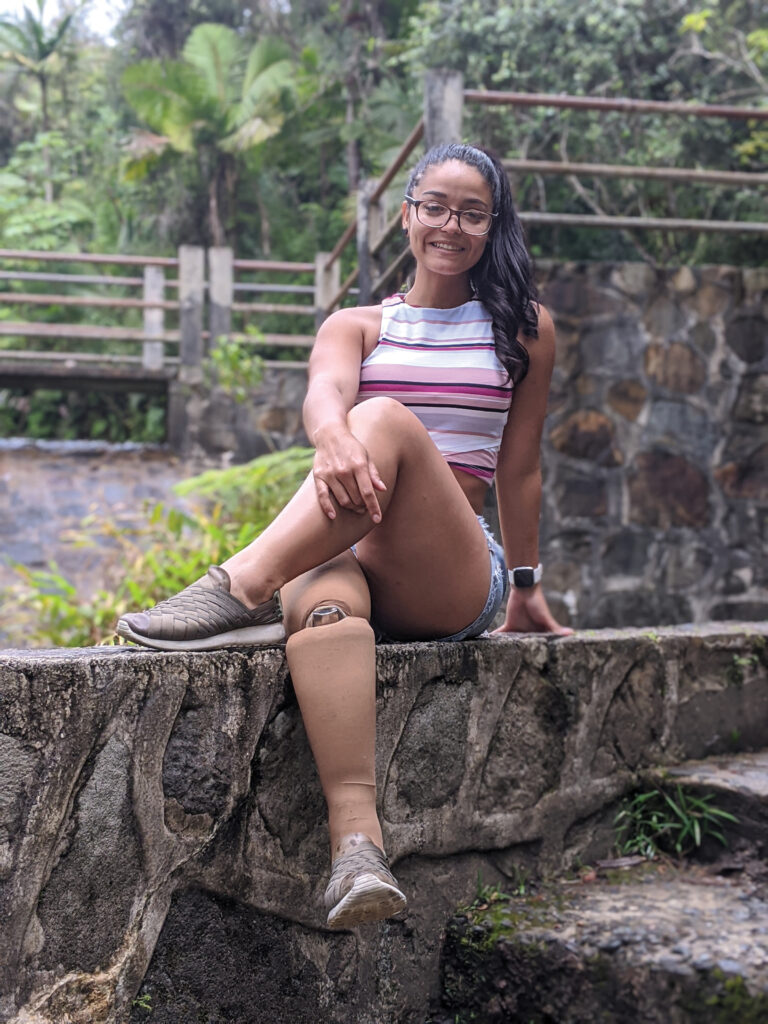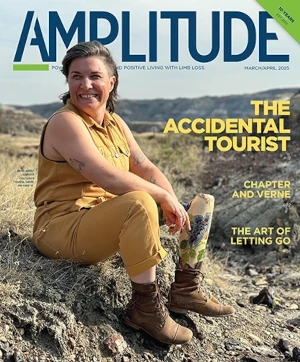By Rick Bowers
“Thank you. Thank you. Thank you,” Jazmine Otero said, as she looked into the video camera, her face beaming with joy.
She’d been given a gift, and she wanted all of her supporters to know how much she appreciated them.
“I cried,” she says of the moment when she realized how much money had been raised through her crowdfunding campaign for her to purchase a new prosthetic leg. “I knew I was surrounded by such beautiful people, but seeing hundreds donating to my cause, with or without knowing me, had me at a loss for words and overflowing with emotion.”

When you need a prosthesis, adaptive sports equipment, or other expensive adaptive equipment to improve your life and all the doors of assistance are closing in your face, a sense of despair and desperation can set in. Since medical bills are the number one reason Americans file for personal bankruptcy, according to a 2019 City University of New York-Harvard study, it’s no wonder that people are trying to solve such problems any way they can.
Even if you have insurance coverage, the premium, deductibles, copays, and coinsurance may be more than you can afford. Many people are, therefore, turning to crowdfunding sites for help.
A 2019 AmeriSpeak Spotlight on Health survey from NORC at the University of Chicago found that an estimated 8 million Americans had started a crowdfunding campaign for themselves or someone in their household, and more than 12 million Americans had started a campaign for someone else.
Like Otero, many amputees have successfully raised funds from friends, relatives, and even strangers through crowdfunding sites such as GoFundMe, FundRazr, Fundly, Plumfund, GoGetFunding, DirectlyTo, StartSomeGood, and Help Hope Live. In August 2018, Fox 13 Tampa Bay reported on a triple amputee who was crowdfunding to pay his travel expenses for an 1,800-mile motorcycle trip to the annual motorcycle rally in Sturgis, South Dakota. In October 2018, Diario AS reported that Nigeria’s amputee soccer team had successfully crowdfunded its trip to Mexico to participate in the World Cup. And in December 2019, The New York Times reported that amputee Paralympic hopeful Morgan Stickney had so far received more than $117,000 through a crowdfunding campaign.
Still, for some amputees, it’s not easy to ask for assistance.
“It was very difficult,” Otero says. “I naturally am a person who would rather look up different ways to do things first before asking anyone for help; therefore, initially, the thought of putting myself out there was a tough pill to swallow.”
But, for Otero, there was simply no other choice.
“I had my previous prosthesis since I was 16, and at the time of creating my GoFundMe, I was 26,” she says. “That is ten years of having the same prosthetic leg that I outgrew.” As a result, she suffered from blisters on her residual limb, muscle cramps, a limp, and back pain.
“On top of that,” she says, “my prosthetic knee was broken, and it made clicking and scratching noises every time I would take a step, which was very embarrassing.”
“I couldn’t afford medical insurance,” she continues, “and I simply couldn’t afford the prosthesis on my own. I both needed and wanted a new leg for health purposes…. I just knew that experiencing the constant leg and back pain and not being able to fully live how I’d like to—to dance or simply enjoy a day at a theme park—was not the lifestyle I wanted for myself.”

According to the Ameri-Speak survey, one in five Americans report that they or someone in their household have contributed to a crowdfunding campaign to pay for medical bills or treatments. Forty-six percent of respondents who donated did so to a friend’s crowdfunding campaign. Sixty-one percent donated to the campaign of either a relative, coworker, or acquaintance (24 percent, 14 percent, and 23 percent, respectively). And, surprisingly, more than one-third (35 percent) donated to someone they did not know personally.
Otero says the success of her campaign was a result of the support of multiple communities, including the salsa and hip-hop dance communities, friends of friends, and friends of family. Her donations were mostly in the $20-$50 range, but she also received a few larger donations—$1,000, $500, and a few $100 denominations.
“Every penny donated made it successful,” she says. “I never thought I’d see anything over a few hundred dollars, but within the first week, I was already over $2,000.”
When Otero created her campaign, she was trying to raise $10,000. An active person who enjoyed dancing, sports, and fitness, she had started a dance group when she was 16 and later taught dancing and competed in dance competitions. Of course, the physical issues related to her old prosthesis had taken a toll in every part of her life and made it difficult for her to pursue her goals.
The new prosthesis changed everything, she says. “I no longer needed a wheelchair for long daily activities; I stopped calling out of work due to pain; I started performing more with my dance partner; and I stopped taking so many painkillers and muscle relaxers. The list goes on. Especially with my self-confidence, I stood tall and walked proud. I am happy that I am now in complete control of the quality of life I have, no longer depending or worrying if one day my leg will fail me.”
Unfortunately, most crowd-funding campaigns do not reach their goals, according to research from the University of Washington (UW). A study published February 8, 2017, in the journal Social Science & Medicine reviewed 200 GoFundMe campaigns for healthcare expenses. It found that 90 percent of them did not reach their financial goals, netting on average just 40 percent of the established goal.
To succeed, it’s important to do what works. Here are a few tips:
- Use crowdfunding for a single, easy-to-solve problem. It’s easier to fundraise for a single need, the UW researchers said, rather than a host of medical costs, car repairs, and utility bills.
- If you are shy about asking for assistance, ask a friend or family member to set up the crowdfunding campaign for you.
- Tell a compelling story. If you don’t know how, seek help from someone who does.
- Be credible. There are plenty of scams out there, and some scammers have used crowdfunding to rip people off. Otero’s video showed her doing various activities with her prosthetic leg, which helped give potential donors confidence that her story was true. Campaigns that don’t have videos but only a photo of the person or product they are seeking are less credible since a scammer can use any photographs copied from the internet.
- Enlist the media. In some cases, if you were involved in an accident or had a severe illness that led to limb loss, the media may have covered your story, making it widely known and believable. If your story wasn’t reported by the media, you or someone else can let the media know about it. Publicity can make a huge difference.
- If you don’t have skills in self-marketing, social media, and video production, seek assistance from someone who does. The UW study found that it wasn’t necessarily the most tragic stories that attracted the most support but the ones that presented a solvable need and most successfully used images, hashtags, memes, and other social media skills. While experts strongly recommend using video, only 3 percent of the studied campaigns did so. Otero’s need—a prosthetic leg—was straightforward and easily solvable with the right amount of dollars. In addition, she told her story well with an interesting video. “My story was shared over a few thousand times between all platforms,” she says. “I think strangers helped because of who I am and how I present myself throughout social media. For instance, my main social media preference is Instagram, and most of what I post is inspirational pictures and videos (or at least I’d like to think so).”
“Do it!” Otero advises other amputees who are considering crowdfunding. “Let your friends and family assist you with how you want to present your goal. Do your research, and always be open to answer all the messages you receive…. I made sure I thanked every person who donated, and I gave people updates on what I did with the money I received.”
While it’s heartwarming to see people succeed in their crowdfunding efforts, it’s also unfortunate that this type of effort is needed.
According to the Ameri-Speak survey, almost two-thirds of Americans think that the government should bear a great deal or a lot of responsibility for providing healthcare to people who need it—more so than charities, hospitals, or doctors. “Although we estimated that, to date, 8 percent of Americans have started crowdfunding campaigns, 26 percent believe friends or family should not assume much or any responsibility for unaffordable medical care costs,” says Susan Cahn, senior research scientist at NORC.
“Looking back at it now, I know that if something were to happen in the future, God will always provide for me,” Otero says. Today, she has a better job with medical benefits and believes her current leg will last her for many years since she is no longer growing and plans to maintain her current physique.
Crowdfunding is certainly not the solution to America’s healthcare crisis and the outrageous costs associated with products and services that people need. It may be a temporary solution to some people’s situations, but society will need to find a better way to address the financial hardships of those who find themselves fighting a disease, involved in accidents, or losing limbs.
“I was overwhelmed to receive so much help, from complete strangers, to family members that I know had financial struggles themselves, to businesses and schools—all who took it upon themselves to see me live a better life,” Otero says. “I am extremely blessed.”
For More Information About Otero
Active Life With Her Crowdfunded Prosthesis
TOP IMAGE: Maksym/stock.adobe.com



